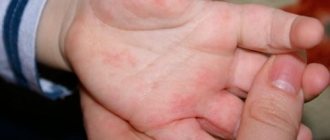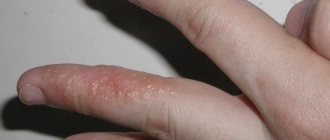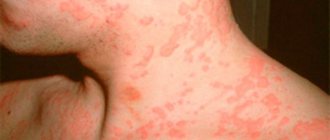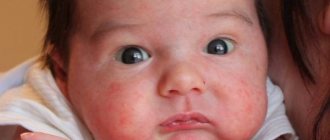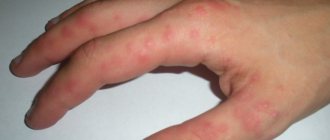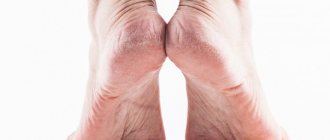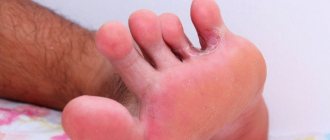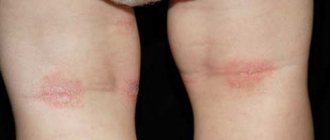A rash on the palms and soles of a child and an adult can be a sign of many diseases. These are mainly signs of contact dermatitis or a reaction to exposure of the skin to toxic and chemical substances. However, there are more dangerous causes of rashes.
A rash can appear as a result of viruses or bacteria entering the body, as well as allergies to various medications and foods. Some diseases can also provoke this condition.
Factors that provoke rash
The causes of rashes on the palms and soles of a child and an adult can be very different. Among the most likely factors are the following:
- infectious diseases;
- allergies;
- damage by parasites;
- inflammatory processes;
- vascular diseases.
Infectious diseases often spread to the entire body, including the feet and palms. Such diseases include rubella, chickenpox, measles, meningococcal infection and many others.
The cause of a rash on the palms can be allergic reactions, since the lesion often occurs at the site of contact with the allergen. The substance can enter the body through food, causing a rash to spread throughout the body.
The inflammatory process can manifest itself as subsequent suppuration on the skin of the feet and palms, as well as subsequent opening of the rash. This happens when an infection is associated with a skin rash.
Among parasitic infections of the hands, the most common disease is scabies. When it occurs, the space between the fingers on the palms is affected, and a characteristic itching occurs.
Prevention
The causes of allergies depend on many factors, but it is better to prevent the disease in a timely manner than to waste energy and money on expensive treatment.
To do this, you should be careful when eating foods, especially for people with a hereditary predisposition to allergies. For this category of patients, a special diet is developed with the necessary vitamins and minerals, while completely eliminating the allergen itself.
It is important to use hypoallergenic cosmetics and household chemicals. If it is impossible to avoid contact with the detergent, protect the palms of your hands with rubber gloves. During the cold season, it is imperative to keep your hands warm.
Allergy
A rash on the palms and feet of a child and an adult often occurs due to allergies, which can appear as a result of interaction with various substances, in particular the following:
- medications;
— chemicals;
- wool of some animals;
- house dust;
- some plants.
Under the influence of various types of allergens, small red rashes can form on the upper side of the palm, as well as many other parts of the body. At the same time, the skin begins to itch very much. Along with the rash, other signs of an allergy appear, for example, the following:
- runny nose;
- sneezing;
- cough;
- suffocation.
It is necessary to carry out diagnostics in order to promptly recognize allergies and begin treatment. A complex of therapy can only be selected by a qualified doctor.
Types of rash
- Blisters are usually observed with dermatitis of an allergic nature, but can be manifestations of herpes, dyshidrosis or eczema. Such rashes have a round shape. Hemorrhagic fluid accumulates under the upper layer of the epidermis. A weeping wound forms at the site of the opened blister. As soon as the disease subsides, the skin becomes clear.
- Bubbles are formed for the same reasons as bubbles, but are characterized by larger sizes. When these rashes burst, a weeping erosion forms, sometimes leaving a scar in its place.
- Pustules appear as a result of folliculitis, ulcerative pyoderma, furunculosis, impetigo. These rashes are inflamed and contain pus.
- Blisters usually occur in response to insect bites, contact with any irritant and are a manifestation of an allergic reaction. They are also observed in toxicoderma and urticaria.
- Spots that do not rise above the surface of the skin appear with the following diseases: dermatitis, vitiligo, leucoderma, syphilitic roseola.
- Nodules occur when the body is affected by HPV, eczema, atopic dermatitis, psoriasis and certain types of lichen. They affect the upper and papillary layers of the epidermis and can have an elastic body, different colors and shapes. The diameter of such rashes ranges from 1 to 3 mm. In some cases, bubbles (papules-vesicles) form on their surfaces.
- The nodes are no more than 1 cm in size (in diameter) and arise for the same reasons as nodules. After they are removed (by surgery, laser or radiotherapy), a scar remains.
Viral infection
A rash on the palms, feet and fever may occur for various reasons. Treatment must be selected in accordance with what factors provoked the disorder. Often this problem is associated with the occurrence of infectious diseases in the body. In addition to rashes and fever, the following signs are observed:
- chills;
- a sore throat;
- loss of appetite;
- abdominal pain;
- cough.
All these signs may be characteristic of various diseases. A similar condition is often observed with the following ailments:
- measles;
- chickenpox;
- meningococcus;
- scarlet fever.
Each of these infectious diseases has its own characteristics and manifestations. Therefore, it is very important to recognize their course in time so as not to aggravate the pathological process. Meningococcal infection is especially dangerous, since its complications can lead to the death of the patient.
Contact dermatitis
A rash on the palms and soles of a child may appear due to contact dermatitis. Basically, this disease manifests itself precisely on that part of the body that is exposed to certain substances (hence the name “contact”).
A rash on the palms and soles of a child often indicates this particular disease, since children tend to pick up everything they come across. A rash due to contact dermatitis can also occur in adults. In them, the appearance of a rash is most often caused by working without gloves with substances that cause contact dermatitis. The rash begins to itch and itch very strongly, and when scratching, an infection can enter the wounds.
Eczema
The main signs of eczema are the formation of inflammation on the surface of the skin, burning and itching. The disease can occur in acute, subacute or chronic form. The symptoms of the disease can be very different, which is why only a qualified doctor can recognize the course of eczema.
At the onset of the disease, patients experience redness of the skin, itching and swelling. These manifestations resemble an allergic reaction, which should subside after eliminating the allergen. If this does not happen, over time the itching intensifies significantly, the patient scratches the skin, thereby violating its integrity. As a result, an infection enters the wounds, a rash is formed, which bursts and forms wet lesions.
After some time, the liquid begins to dry out, and the skin becomes thickly covered with crusts. Eczema begins mainly from the head and arms, and then gradually moves to the legs. The disease often becomes chronic and lasts for years.
Rash due to infectious diseases
Rashes in infectious diseases are often characterized by stages of appearance, first it appears in one place, then in another, also for each infection there are typical places for rashes, a specific shape and size, it is important to remember all the details and, when interviewing, report all this information to the doctor.
Below we look at rashes associated with various infectious diseases:
Rubella - in the initial period of the disease, a small rash appears on the face and neck, then within 2 to 6 hours the rash spreads throughout the body. Usually appears as round or oval redness ranging from 2 to 10 mm in size. Remains on the skin for up to 72 hours, then disappears without visible traces.
If you find yourself with a similar rash, you need to consult and examine a doctor, since similar rashes are symptoms of many infectious diseases. We also recall that rubella poses a particular danger to pregnant women, since if the mother is ill, the infection can harm the fetus.
Measles – the disease measles usually manifests itself with catarrhal manifestations. The rash appears after 2-7 days. The primary places of protrusion are on the skin of the nose and behind the ears, then within 24 hours it spreads to the skin of the chest, face, then the arms and neck also become covered with rashes.
Chicken pox - at the onset of the disease it manifests itself as red spots, then bubbles with a red ring and liquid inside appear, similar in appearance to dewdrops. After two days, the outer surface of the bubble collapses and becomes less elastic. Subsequently, the blisters become coarser, crust over and disappear within seven days without leaving any visible traces.
Scarlet fever - Rashes with scarlet fever appear 24 hours after infection, the areas of active manifestations are the back, groin, elbow and knee bends, and armpit skin. Then inflammation appears on the skin, sometimes there is a slight blue discoloration in the places where roseola forms. The face with scarlet fever is usually not affected by a rash.
Erythema
A rash on the palms and soles of a child can form when erythema occurs. The presence of this disease is mainly indicated by the formation of red spots, however, manifestations of erythema can also be in the form of individual red nodules.
Erythema is formed as a result of excessive blood flow to the vessels. If this disease is physiological, then no specialized treatment is required. Prolonged erythema may indicate the occurrence of some pathological process in the body. This disease can be caused by many different reasons, including:
- dermatitis;
- infectious diseases;
- circulatory disorders;
— carrying out physiotherapeutic procedures;
- cold damage and sunburn.
When erythema infectiosum occurs, severe headache, fever, and peeling occur after the rash goes away. In some cases, pain in muscles, joints, and signs of intoxication may appear.
Vascular diseases
When diseases of the cardiovascular system occur, rashes can also form. A rash in a child appears due to a decrease in the number of platelets involved in blood clotting, as well as a violation of capillary permeability.
Rashes due to disorders of the vascular system and blood diseases may indicate the presence of a serious pathology, therefore, hospitalization is necessary for comprehensive diagnosis and treatment.
Skin infection by parasites
Skin lesions on the palms and soles are caused by scabies mites. Among the main signs of scabies, it is worth highlighting a rash and itching, as there is an allergy to the scabies mite and its waste products. If you scratch the skin very hard, infection can enter the wounds, which leads to the formation of pustules.
Scabies is characterized by the presence of subcutaneous passages that are gnawed by mites. Often the lesion is observed between the fingers, on the bends of the elbows and knees, and in the lower abdomen. The scabies rash appears as small red nodules that can gradually merge with each other. The danger of this disease lies in the likelihood of a secondary infection.
What are papules and pustules: signs and treatment
Skin rashes that originate from comedones are called papules. They manifest themselves in the form of specific neoplasms on the skin. In appearance they resemble a small nodule that does not have an internal cavity.
Papules are spoken of only in cases where the nodule has no internal contents and is located above the surface of the skin or mucous membranes. The presence of pathological elements - papules - indicates various pathologies - psoriasis, eczema, acne, etc.
According to statistics, papules are most often localized in the area of the upper and lower extremities, on the patient’s face. But the location of the localization is mostly determined by the specific disease. If you have one pimple, there is no reason to panic; if there are many of them, you need to visit a dermatologist.
Let's consider what papules and pustules are, and how do pathological elements differ? What rashes appear during the development of psoriasis, and treatment features.
- What do papules look like on the skin and what are they? Features of papules in psoriasis
- What is a pustule?
- What does the presence of pustules on the skin indicate?
- Body
What do papules look like on the skin and what are they?
So, papule, what it is, let’s look at it in detail. A papule is a nodular neoplasm of a benign nature on the skin, which rises above the surface of the skin and does not have an internal cavity.
In reality, every person has had papules. For example, the mantoux reaction is always accompanied by the appearance of this element. Everyone remembers how, in childhood, a nurse carefully examined the formation after a mantoux test. This was necessary in order to distinguish between post-vaccination immunity and infection (that is, a positive reaction to the test).
The difference is that the papule that forms after administration of the vaccine is not characterized by clear contours, the color is pale pink, and there is no pigmentation. A post-infectious neoplasm has a more intense color, clear contours and pigmentation, which lasts about 14 days.
Features of papules in psoriasis
Despite the advanced level of medicine, doctors still do not know the exact cause of psoriasis. Although many scientists are inclined to the hereditary factor.
Papules on the skin may look different depending on the type of psoriasis:
- Plaque form. The formation on the skin is red, the boundaries are clear and even. Elements tend to appear on the scalp and body. Rarely, plaque psoriasis is diagnosed on the face, feet, and palms. Peeling is present, and if the scales are removed, local bleeding occurs.
- The teardrop shape is characterized by the presence of papules on human skin and is small in size. New growths throughout the body. This type of disease is often diagnosed in adolescents and young children.
- Pustular form. Neoplasms affect the palms and soles of the extremities. There is pain when touched.
The most severe forms of the disease are psoriatic erythroderma and generalized pustular psoriasis. In addition to skin symptoms, there are systemic signs of pathology - increased body temperature, chills, weakness. The patient requires immediate medical attention.
What is a pustule?
It is difficult for a person who does not have a medical education to distinguish one skin element from another. For many, a vesicle, papules, pustule, etc. are the same thing. But that's not true. Papules and pustules are different.
A pustule is a pustular neoplasm, which is a distinctive feature in comparison with a papule, which is represented by a nodule. Pustules always rise above the skin, but they are easy to distinguish from papules - there is always a purulent process.
They are flat in shape or similar to a small growth in the form of a ball. The immediate cause is the necrotic state of the epidermis. Most often detected in the area of hair follicles.
Pustules most often affect the hands and face. Their occurrence is spontaneous.
Classification and types of papules
There is a classification of papules on the skin. They can be non-inflammatory in nature (closed and open, milia) and inflammatory in nature (follicular papule, pustule, nodules).
They are classified according to color - pink, red, brown and purple.
And in shape - round, oval, polygonal.
Depending on the depth, the papular rash can be of the following types:
| Variety | Description |
| Superficial | Flat neoplasms, size up to 5 mm inclusive, sometimes redness is present. The reason is hypertrophy of the epidermis; there is no pain syndrome. |
| Deep | The epidermis and layers of the dermis are affected, and pain appears on palpation. After disappearance, scars remain (often, but not always). Color – pink, blue, purple, red. |
| Cysts | They are formed when the contents of the infiltrate do not come out completely. A capsule is formed, which is filled with sebum and purulent masses. |
Etiology of pathological elements
The appearance of papules has many causes.
The main factors include the accumulation of infiltrate due to the inflammatory process in the dermis.
Other causes are hypertrophy of 1 or several layers of the skin, tumor growths, hormonal imbalance, pathologies of the liver, kidneys, and poor nutrition.
Papules often indicate the development of psoriasis.
What does the presence of pustules on the skin indicate?
By developing a papular rash, the body of men and women can react to the inflammatory process. Blocked pores cause oil to accumulate in the ducts and hair follicles, causing microscopic cysts to form. When their shell is damaged, the contents enter neighboring tissues, which leads to the appearance of papules.
The presence of papules on the body and face signals the development of such diseases:
- Syphilis.
- Eczema.
- Atopic dermatitis.
- Psoriasis.
- Amyloidosis.
Piezogenic heel papules are somewhat different than papules associated with psoriasis or other dermatological diseases. This is a hernia of the fatty tissue of the heels. The neoplasms are 7-10 mm in size and do not differ in color from other areas of the skin. They develop against the background of excess pressure on the limbs, resulting in bulging of adipose tissue into the subcutaneous tissue.
Reasons for appearance:
- Hereditary factor.
- Pathologies of cardiovascular nature.
- Regular and excessive pressure on the limbs, for example, if a person plays sports professionally.
- Obesity.
Most often they appear in women, rarely in men. Almost never in childhood.
Treatment is prescribed only in cases where the skin defect is accompanied by pain or discomfort.
Location of papules
Papules can appear on any part of the skin. They differ in color, size, and reason for their appearance.
Body
They develop for various reasons, ranging from inflammation to malignant tumors. At first, the patient discovers a small pimple on the skin, but after a while it grows. Papules tend to grow up to 3 centimeters. As it increases, painful sensations come with it.
Face
The cause is an inflammatory process in the upper layers of the epidermis. The pathological process begins with blockage of pores, due to which the skin secretion is produced in a larger volume. This leads to the formation of cysts, which become damaged over time and appear in the dermis.
The size of neoplasms on the face is usually small - diameter 4-6 mm. There is no pain, but there may be itching. It is better not to treat rashes of this type on the face on your own, since the likelihood of success is low and the disease will begin to progress.
Genitals
Men usually develop pearlescent rashes. Blockage of the sebaceous glands can contribute to the rash. But this is a theory. There are no exact reasons.
Localization - around the head of the reproductive organ. In appearance, the rash resembles a row of pearlescent balls. They don't bother me at all. According to doctors, such papules are a cosmetic defect and are generally normal; no treatment is required.
Diagnosis and treatment features
Diagnosis begins with a visual examination of pathological elements. In a number of situations, it is not possible to make a diagnosis, so additional studies are carried out - a blood test (general and biochemical), histology or bacterial culture of the exudate of the vesicles.
Treatment is determined by the origin of the papules. Thus, the patient is recommended to carefully care for the skin. If a bacterial infection is present, topical antibiotics (Skinoren) are prescribed. Use 2 times a day, applied pointwise.
For psoriasis, treatment depends on the stage of the disease. For example, to relieve exacerbations, external agents and oral tablets are used. The regimen is always complex and may include drugs:
- Suprastin (antihistamine tablets).
- Allohol (to strengthen the liver).
- Mezim (to improve the digestive process).
- Polysorb (enterosorbent).
- Antibiotics.
- Nise (non-steroidal anti-inflammatory drug).
- Immunosuppressants (to suppress the immune system).
To relieve symptoms, local medications are used. These are Momat, Dermovate, Nazacort, Diprospan.
If the papules are viral in nature, then hardware methods are used for removal - cryotherapy, laser coagulation. Pearlescent papules on the genitals are removed using laser and electrocoagulation.
Papules and pustules accompany many diseases - syphilis, psoriasis, eczema, allergies and even smallpox. Only a dermatologist can differentiate the pathology. Self-medication can lead to disastrous results.
Enteroviral disease
Quite often a rash occurs on the palms and soles of a child with hand-foot-mouth syndrome. This viral disease is highly contagious and manifests itself in the form of nodular rashes on the palms, soles, and mouth.
This disease mainly affects children, but it can also occur in adults. The causes, symptoms and diagnosis of hand-foot-mouth syndrome can be different, so it is important to promptly differentiate enteroviral disease and carry out treatment. In general, the prognosis for this disease is good, but in some cases serious disorders in the nervous system can occur. An increased risk of complications is observed before the age of 3 years. Among the main complications are the following:
- meningitis;
- encephalitis;
- polio.
In some cases, the disease can lead to the death of the child. More serious complications can occur during pregnancy, especially in the first trimester, since such a disease threatens miscarriage. Apart from the formation of blisters, all the signs of the flu are present.
be careful
People suffering from psoriasis often make one big mistake:
The patient is trying to eliminate the external signs of the disease, but eliminating the external manifestations of psoriasis does not solve the problem from the inside.
Roughly speaking, even if it is possible to remove the signs of psoriasis from the outside and put the skin in order, inside the body the disease continues to devour the autoimmune system, which provokes severe diseases, many of which are fatal. Particularly scary is the fact that psoriasis can provoke cancerous tumors.
The only remedy that is currently available for self-use by patients with psoriasis is the special product “PsoriControl”, which is available at a discounted price. Read the details in the official source.
Psoriasis on the fingers and toes is a chronic dermatological disease that has not yet been thoroughly studied by specialists. At this point in time, there is no particular progress towards the emergence of an effective method of curing psoriasis.
The detection of this type of dermatosis on the fingers accounts for more than half of all cases of manifestations of varieties of this disease that can affect healthy areas of skin throughout the patient’s body.
It would seem that psoriasis on the fingers or toes does not pose a threat to human life. But it is worth remembering that refusing treatment can worsen your health condition and lead to serious complications that cannot be called harmless. In particular, psoriasis can provoke arthrosis of the joints of a psoriatic nature, leading to severe disorders in the functioning of the musculoskeletal system.
In turn, the development of complications can cause a decrease in working capacity up to complete paralysis. It is impossible to cure psoriasis, but by adhering to a number of principles and complex methods it is possible to lengthen periods of remission and reduce the number of relapses of the disease.
Psoriasis on fingers, photo
The primary symptoms of the disease on the fingers are clearly expressed; it is simply impossible to ignore it. Single reddish rashes form in the area between the fingers. Often nothing predicts their appearance; it happens suddenly.
Most often, a person mistakes a small rash for an allergic reaction without taking special treatment measures. The maximum that a patient encountering this phenomenon for the first time does is take an antihistamine.
The alarm begins to sound when scaly formations of a grayish tint appear. At the same time, people who are unfamiliar with the nature of the disease mistakenly consider themselves contagious and become isolated, limiting communication with friends and acquaintances. In fact, this is not true, psoriasis is not contagious!
Most often, psoriatic elements appear on damaged areas (small cracks, scratches and scratching areas).
initial stage
The skin on the fingers becomes covered with tiny pustules. Their distinctive feature is the roundness of the shape and a smooth surface with a clear shine, the contours are clearly defined.
After some time, peeling begins, accompanied by the separation of grayish-white scales. After peeling off the scales, the glossy surface of the papule is visible; this is usually called the terminal film.
Then the process of development and aggravation of rash formations is observed. The plaques increase in size and cover an increasingly larger area.
In this case, three phenomena accompanying the disease are distinguished: the stearin stain effect, the blood dew phenomenon and the psoriatic film.
Psoriasis on the toes, photo
The disease does not always look the same; its manifestations depend on the type of disease.
Have you been trying to get rid of PSORIASIS for many years?
Head of the Institute: “You will be amazed at how easy it is to get rid of psoriasis by taking it every day...
Read more "
In the case of the most common plaque type, these will be round papules, as if lying on top of healthy areas of the skin. The surface layer of the epidermis is hyperemic around the area, and the papules themselves have a loose, flaky structure.
The pustular form is characterized by a blistering rash, with each vesicle containing exudate. The temperature of the skin around the affected areas is increased. The patient suffers from itching. However, you should not scratch off the rashes, as this increases the likelihood of infection in the open wound and the appearance of various complications.
Treatment of psoriatic rash on the toes is complicated by the fact that the area is often subject to friction from wearing socks and shoes. The lesions itch more, and scratching the irritated papules again leads to an increase in their number and size.
In addition, increased sweating aggravates the situation. Sweat itself is not dangerous, but it provokes the proliferation of pathogens.
initial stage
The beginning of the development of psoriasis on the toes is not much different from the primary stage of manifestation of this disease on the upper extremities. The patient begins to be bothered by the itching of a reddish rash that appears, which quickly begins to peel off and become covered with scales.
Psoriasis can affect the nail beds. In this case, they acquire an unhealthy yellowish tint, become dense and at the same time loose, easily damaged and delaminate. Tiny pits are formed on the surface of the nail, reminiscent of the indentations of a thimble, which is why this effect received the name of the same name. Minor hemorrhages occur in the area of skin under the affected nail; symptoms of inflammation can be recognized. If you start the course of a nail disease, then if the disease becomes severe, you can easily lose the nail plate completely.
Causes
No single cause of psoriasis on the arms and legs has been identified. However, thanks to multiple scientific studies and observations of people suffering from this disease, it was possible to put forward several theories about the factors that encourage its manifestation.
There are two versions of the nature of psoriatic rashes:
- Failure of the body's immune system;
- Dysfunction of the skin.
Immune dysfunction is expressed in the abnormal production of various substances that form lesions on healthy areas of the skin.
In the second case, healthy skin cells reject excess epidermal cells that mature in a certain place.
The disease can manifest itself as a result of the following factors:
- Diseases of the digestive and gastrointestinal tract;
- Hormonal imbalance (increased concentration of some hormones and decreased content of others);
- Hereditary tendency - if this diagnosis was established for one of the parents, then the risk of the child increases by a third, and if both parents have it, then by almost 80%;
- Patient's predisposition to allergic reactions;
- Other types of dermatoses;
- Mechanical damage to the skin (cuts, bites, scratches, tattoos);
- Constant nervous tension or sudden severe stress;
- Infectious diseases, especially in acute form (including HIV, AIDS);
- Uncontrolled use of medications;
- Negative effects on the skin of the hands of harmful substances (in household chemicals, medicinal or cosmetic creams and ointments);
- Toxic effects on orgasm of bad habits (smoking, consumption of alcoholic beverages);
- Weakening of the body as a result of pregnancy and labor in women.
Psoriasis leads not only to psychological discomfort and an aesthetically unsightly condition of the fingers and toes, but also to their physical ill health. With this type of disease, the likelihood of atrophy of the hinge joints connecting the phalanges of the fingers increases, as well as a decrease in sensitivity and motor ability.
Treatment
If symptoms of psoriasis appear on the fingers and toes, treatment is not limited to just the application of external medications, it is complex and includes several diverse measures. They depend on the stage of development of the disease and its form. Most often this is:
- General therapy - the patient is prescribed medications:
- Antihistamines, which reduce the body’s allergic reaction;
- Sedative, preventing the development of depression and nervous exhaustion;
- Mild sleeping pills;
- Immunomodulatory and immunostimulating, increasing the body's resistance to pathogenic factors;
- Sorbents, drugs that help restore normal functioning of the digestive system;
- Vitamin complexes.
- Local therapy – patients are prescribed:
- ointments with anti-inflammatory effects;
- recurrent medications (ichthyol and tar ointments);
- in case of severe exacerbation of the disease, corticosteroids are used - ointments created on the basis of hormonal agents.
- Physiotherapy - includes ultraviolet irradiation procedures, photo- and chemotherapy, and paraffin applications.
- Proper nutrition and a healthy lifestyle are an unconditional part of anti-psoriasis treatment, based on giving up bad habits, junk food and following a balanced medicinal diet.
The method of treating the disease at the initial stage is gradually changing. Dermatologists refuse to use cytostatic medications and hormonal ointments for mild forms of the disease, since their list of serious side conditions is very long. Increasingly, they are resorting to the use of non-hormonal topical drugs.
These funds help:
- Removing the dead layer of the epidermis;
- Softening the skin;
- Promote deep penetration of other drugs;
- Reduce the growth and development of new cells, due to which psoriasis plaques disappear faster;
- Eliminates severe itching.
Only if these drugs are ineffective are more serious medications used.
Folk remedies
There are many ways to self-treat psoriasis using alternative medicine methods. However, there is a risk that the recipe that is suitable in this particular case will not be selected the first time. Therefore, when the first symptoms appear, you should not limit yourself to folk remedies; it would be more correct to carry out treatment in combination with traditional methods prescribed by a specialist.
Variants of traditional methods using:
- Celandine.
The decoction of the medicinal herb is infused, filtered and added to baths with warm water. Then they lower their arms or legs there. Such procedures are effective with frequent and long-term use.
An ointment from dry stems, ground to a powder, is prepared by adding turkey fat and boiling the resulting mixture in a water bath for about 1 hour.
- String and St. John's wort, valerian.
The preparation of the tincture follows the same principle as in the case of celandine. It is important that the broth cools down before pouring it into the bath, otherwise there is a risk of burns and even greater damage to unhealthy areas of the dermis. String and St. John's wort have an anti-inflammatory and antibacterial effect, and valerian has a soothing effect that relieves itching.
- Birch tar.
Tar ointments, prepared independently using vegetable oil, are rubbed into the affected parts of the fingers for several weeks, but the first changes in the condition of the epidermis will become noticeable after three to four days. Tar is rightfully considered one of the most effective means in the fight for healthy skin.
- Egg yolks.
To prepare this product, finely chopped boiled chicken egg yolks are fried in a frying pan, the resulting liquid is drained, and the yolk mass is cooled. Then they lubricate the plaque-covered fingers and toes with it.
- Propolis.
Add propolis to melted butter in a water bath, mix thoroughly and cool to room temperature. Apply as often as possible to pathogenic cells of the dermis and leave until completely absorbed.
There are many methods for treating psoriatic rashes, but it is still better to adhere to preventive measures after the disease enters the remission stage so that exacerbations do not occur for as long as possible. To do this, you should eliminate all provoking factors and take care of your skin, moisturizing it and not once again exposing it to harmful household chemicals.
At the initial stage of development of psoriasis on the fingers, it is important to promptly contact an experienced dermatologist who is familiar with the etiology of this disease and is able to prescribe the correct course of treatment. People suffering from psoriasis often need adjustments to their mental and emotional state, so consulting a competent psychologist would not hurt.
+ =
I accept the user agreement and privacy policy
- Categories
- It is important to know
- Diet
- Other means
- Crema
- Treatment
- Ointments
- Folk remedies
- Reviews
- Symptoms and signs
- Pills
- Photo
- Shampoos
Types and stages
- Recent Entries
- Effective irradiators and lamps for psoriasis at home
- What drugs to use against psoriasis
How to use acid for psoriasis
Headings Select a heading Important to know Types and stages Diet Other remedies Creams Treatment Ointments Folk remedies Reviews Symptoms and signs Tablets Photos Shampoos
Features of rashes in children
When various diseases occur, one of the main symptoms is the occurrence of a rash, therefore, it is necessary to determine in time the nature of the rash, as well as the causes of its occurrence. The rash can affect the skin of infants and children. Common reasons include:
- dermatitis;
- chickenpox;
- prickly heat;
— contact with poisonous plants;
- insect bites.
Chickenpox is characterized by widespread red, watery blisters that cause significant discomfort and itching. Young children often scratch the blisters, causing a crust to form in their place. Miliaria is characterized by the fact that a small rash can affect absolutely any area of the skin. In the absence of sufficient hygiene, prickly heat can develop into more serious diseases.
Any manifestation of a rash should be a cause for concern, as the cause may be a serious illness.
Features of the rash in adults
In an adult, a rash on the palms and soles of the feet occurs quite rarely, since the skin is much rougher and thicker than that of a child. However, the rash may occur frequently on the back of the hands. Blisters may indicate the presence of allergic dermatitis, eczema or herpes. Pustules may indicate the presence of furunculosis, folliculitis and other diseases. If blisters occur, we can talk about the presence of an allergic reaction to local contact with the allergen.
Spots can cause dermatitis, vitiligo, leukoderma, and nodules form with psoriasis, dermatitis, lichen, and eczema.
Causes of rash on palms and soles
The appearance of rashes and itching is influenced by both external and internal factors. The main reasons for this problem are:
- inflammatory processes;
- allergy;
- exposure to parasites;
- vascular diseases;
- infectious diseases;
- violation of personal hygiene rules;
- metabolic disease.
A rash with itching on the palms and soles occurs in the form of pustular formations, peeling, and red spots. To find out the true cause of its occurrence, it is better to consult a doctor. After conducting a blood test and taking scrapings from the affected areas, the specialist will make a diagnosis.
Dyshidrosis
With this infectious pathology, the rash is localized on the palms and soles, and appears as blisters containing liquid inside. Most often, dyshidrosis develops in the summer, which is caused by blockage of the sebaceous glands. Factors that provoke the occurrence of this disease are the following:
- increased sweating;
- allergy;
- constant nervous shock;
- fungal skin infections;
- burdened heredity;
- disruptions in the functioning of the endocrine system;
- gastrointestinal pathologies.
According to E.O. Komarovsky, dyshidrosis in a child usually develops as a result of an allergy to food products introduced into the diet. For this reason, parents need to keep a food diary. Sensitization to cow's milk protein is often observed.
Symptoms of dyshidrosis:
- rashes, which are most often localized on the palms, feet, legs and the inside of the fingers;
- at an early stage of the disease, an unpleasant tingling occurs in the palms and feet, the affected skin itches, and a rash appears at the site of scratching, accompanied by itching and burning;
- the palms and feet become red, and transparent itchy blisters (several millimeters in diameter) form on them, containing liquid inside;
- after 7-10 days the rashes disappear (dry out or open spontaneously);
- the healing process is accompanied by unpleasant sensations, erosions form on the affected areas;
- The final stage of the disease is peeling of the skin.
After the bubbles disappear, new ones no longer appear. If you contact a specialist in a timely manner, the pathology can be easily treated. In most cases, it is recommended to take antihistamines, enterosorbents, and sedatives (for example, valerian tablets). Sometimes it is necessary to drink calcium.
For external use, products with an antimicrobial and drying effect are used (zelenka, fucorcin, sudocrem, zinc ointment). Corticosteroids (sinaflane, loriden) are actively used.
Traditional methods suggest applying a cabbage leaf or fresh grated potatoes to the wounds.
Enteroviral vesicular stomatitis caused by the Coxsackie virus
This disease is most often diagnosed in children from one to seven years of age (in rare cases, adults suffer from it).
Body temperature rises to 39 degrees, and during this period there are often no rashes. After three days, a rash spreads across the skin, affecting not only the feet and palms, but also the mouth and the area around it. The rash is accompanied by itching and appears as pale red spots with a diameter of no more than 2 mm. Due to the localization of the virus in the mouth, a person may refuse to eat. The routes of infection are contact and airborne droplets. It is advisable to temporarily isolate a sick family member from the rest.
Treatment is usually long-term (on average 14 days). It is recommended to drink plenty of fluids and, if necessary, use antipyretics and antihistamines.
Atopic dermatitis
Atopic dermatitis is considered the most common cause of skin rashes (affecting about 30% of adults in developed countries).
By its nature it can be simple (occurring immediately) and allergic. The latter develops as a delayed reaction due to the body’s increased sensitivity to external irritants, which are often chemicals that come into contact with the skin (detergents and cleaning products). Less commonly, atopic dermatitis is a manifestation of an allergic reaction to foods or medications.
With atopic dermatitis, the rashes look like small red spots, which sometimes increase in size, become inflamed and look like chickenpox or acne. The skin cracks and thickens. The rash is usually accompanied by itching.
Allergy
Manifestations in the form of rashes and itching usually occur on the inside of the palms, as well as on other places on the body.
This happens due to the entry of substances foreign to the body into the blood. Poor quality food can also cause an allergic reaction. This is especially true for a child, with his immunity not yet fully formed. Outwardly it looks very much like urticaria. The body's protective reaction manifests itself as dermatitis on the skin of the hands, which is accompanied by itching. Sensitization occurs, that is, the production of antibodies. Allergy manifestations have acute and chronic forms.
- The result of acute dermatitis is swelling and redness of the skin. In this case, rashes appear that resemble watery blisters, sometimes with bloody inclusions. With physical impact, the vesicles burst, leaving crusts.
- The chronic form is characterized by lichenification, which leads to cracking, keratinization and even atrophy of human skin.
Treatment begins with identifying the allergen and immediately eliminating its exposure. To do this, you must undergo a medical examination. Food allergies can be eliminated by eliminating the harmful product from the diet.
Other types of disease require the use of special ointments and antihistamines. Particularly complex cases require the use of hormonal therapy. This is why the help of a dermatologist is necessary.
Sensitivity to hygiene products
If the rash is localized on the feet and palms, this usually indicates an increased sensitivity of the body to hygiene products. The following features are observed:
- the rashes look like small red spots that itch very much;
- after 2-3 days they increase in size to 3 mm;
- new rashes appear due to scratching of the skin;
- body temperature does not rise.
If the culprit of the rash is an unsuitable hygiene product, then you must stop using it, take antihistamines, and use special creams and ointments to eliminate skin manifestations (fenistil, triderm).
Hives
A special type of allergy is urticaria, in which itchy pale pink blisters appear on the body, raised above the skin, looking like burn marks from contact with nettles. Urticaria is uncommon in children; it usually affects adults (mostly women) aged 20 to 60 years.
Infections
A small rash with itching on the palms and soles of adults and children can be a consequence of an infectious infection, for example, rubella, meningococcus, scarlet fever, measles. All the signs of an infectious disease are also present. A rash with deadly meningococcus should be especially alarming. It bleeds and is accompanied by fever. Treatment is carried out only after consulting a doctor.
Parasites
The mite that causes scabies is able to exist thanks to the microscopic passages it gnaws in thin layers of the skin. Its bites cause redness and a rash that itches a lot, especially at night. This type of problem requires immediate attention to a specialist, as the disease is contagious.
Vascular disease
Hemorrhagic rash occurs after inflammation of small capillaries and vessels. It looks like a subcutaneous hemorrhage in the form of points that can merge, occupying fairly large areas of the skin. Treatment is prescribed by a doctor.
Carrying out treatment
How to quickly treat rashes on the palms and soles of children? This question interests many parents. At the very beginning of the appearance of rashes, you should consult a dermatologist, since it is very difficult to get rid of the rash on your own. The exact cause of the rash can only be determined through a comprehensive diagnosis. The causes and treatment of rashes on the palms and soles can be very different, for example, antihistamines are prescribed for allergies, and antibiotics are prescribed for infections.
During therapy, topical ointments and creams must be prescribed. Such products will help cope with itching, scratching, pain, and skin irritation.
